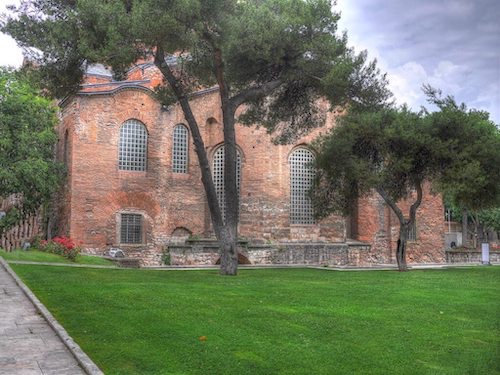
Saint Irene is the greatest church of Byzantine. The ancient sources suggest that Saint Irene was built during the reign of Constantinus I (324 – 337) in the early 4th century on the ruins of the Roman temples of Artemis, Aphrodite and Apollo. Saint Irene, which is located within the same yard as Hagia Sophia, was burned along with Sempson Zenon, which was located adjacent thereto, during Nika Riots of 532. In the aftermath, Emperor Justinian had Saint Irene as well as Hagia Sophia rebuilt. Even though the construction was started in 532, the date of completion is not known definitely. The strong earthquakes, which occurred in the 8th and the 9th centuries, caused considerable damages on the church. Saint Irene, which was referred to as the Patriarchate's Chapel by the Byzantine, became a part of the domain inside the Imperial Walls, which surrounded Topkapi Palace, after the conquest of Istanbul. Thus, since it was not converted into a mosque, it did not undergo any significant architectural modification after the conquest of Istanbul in 1453. It was used initially as the internal armory and subsequently as the arsenal of the Ministry of War. The first museum of the Empire was opened in Saint Irene in the 19th century when the weapons kept in the armory became antiques. The double-leaf stairs, which enable the access to the galleries, were constructed when the structure was turned into a museum. The Ottomans added the inscription, dated 1726, and the said stairs to the ancient church.

Constantinus, while he was reconstituting the city, had a forum, a palace and a hippodrome built for his name and he also had the Church of Saint Irene built on the Roman temples in 330s. Hagia Eirene, the original name of the church, means “Holy Peace” and was named after a female saint, who lived in the same era. The original name of the saint was Penelope. Penelope devoted her life to spread the doctrines of Christianity. She was thrown down a well full of snakes by the pagans, but she survived. She was then stoned, and tied to horses and dragged, but she survived. Subsequently, the pagans converted into Christianity after witnessing her miracles, and Penelope was named Irene. Thus, Emperor Constantinus named the first temple of the monotheistic religion after her as Saint Irene or Hagia Eirene.

The researchers believe that the archaeological ruins, which were discovered to be adjacent to Saint Irene are the ruins of the well-known Samson Xenedokhion (hospital/ old people's home) or the Episkopion (the Bishop's Palace) of the Byzantine era. In some parts of the ruins, the passages from the southern nave and the yard of Saint Irene to certain parts of the ruins are still visible even being currently covered. Thus, it is established that the ruins belong to a structure, which was directly connected with Saint Irene. The cistern, which remained covered in a small unit on the east of the ruins probably extends to the Ottoman guard post built in the 19th century. The large cistern, which is currently known to extend to the first yard of the palace below the guard post and to head toward the Imperial Walls, is believed to be related to the said group of structures. While one of the entrances of the cistern is seen to be located in front of the Imperial Walls, a well curb of column capital of the early Byzantine era and another entrance is located on the north of the structure.



Saint Irene is the only church with an atrium from the Byzantine. Atrium is what a cloister, which used to be characteristically located in the center of ancient Roman temples, was called. Saint Irene still maintains the characteristics of the ancient Roman temple, which used to be its predecessor in location. However, the Saint Irene, which currently stands on the same spot, is not the original one. The original Saint Irene, which was a wooden structure, burned in 532. The people, who rose in riot when Emperor Justinian prohibited polytheistic beliefs, burned both Hagia Sophia and Saint Irene on behalf of Zeus. Even though Justinian had Hagia Sophia and Saint Irene rebuilt, Saint Irene burned once again in 564, and was repaired. The church underwent the third repair when it was damaged by the earthquakes. The interior is closed, unless you are a part of a group of ten or more. Today, the museum serves mainly as a concert hall for classical music performances, due to its extraordinary acoustic characteristics and impressive atmosphere. Many of the concerts of the Istanbul International Music Festival have been held here every summer since 1980.
[mappress mapid=”36″]
References:
Saint Irene: http://www.mymerhaba.com/St-Irene-Church-in-Turkey-333.html
Saint Irene: http://www.greatistanbul.com/hagia_irene.htm

